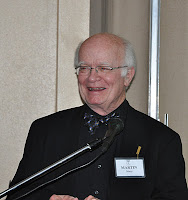Church Affiliation Colonial and Now -- Sightings (Martin Marty)
Ah, the good old days, when America was a Christian (Protestant) dominated Eden. Oh, if only we could go back. There has been a strong "restorationist" impulse in American life. We've looked back at the past and tried to find touchstones that mark a sense of primitive purity. My denomination the Disciples of Christ, is rooted in one of those movements, born as it was on the American Frontier early in the 19th century. As observers look out at the current scene, with the dominance of Christianity receding, so that not only are Mainline Protestant churches shrinking, it's affecting everyone. So, in the face of this, do we look back with nostalgia. In this week's edition of Sightings, which I'm reproducing later in the week due to my earlier political coverage, Martin Marty takes a look at the question. I invite you to consider his words and add your own thoughts. Where are we in relation to earlier days? Is this good or bad? Is the movement away from institutional religion to freer spirituality a positive or negative sign? Take a read; offer a thought.
**************************
Martin Marty Center for the Advanced Study of Religion
The University of Chicago Divinity School
The University of Chicago Divinity School
Sightings 11/5/2012
Church Affiliation Colonial and Now
-- Martin E. Marty
Suddenly it has dawned on pundits and publics that decline in religious affiliation and participation demands notice. Editorials on the subject abound. Some of these celebrated the liberation of society from religion, though descriptions of what is replacing it are seldom seen as satisfying (spiritually, philosophically, politically). We’ll talk about that some other day. Others use the statistics of decline to scold those whom the editorialists blame: liberals, secularists, compromisers, sell-outs. Still others use the data to inspire counteraction: a search for new strategies, fresh theological statements, understanding the alienation of so many of the young from religious and other institutions. You will even find some of the Catholic and other churches who argue that statistical decline might leave the nation and its churches with leaner, purer memberships and affiliations.
So how were things in the good old days? A consensus questioned by a few serious scholars—Patricia Bonomi among them—is that fewer than 20 percent of the colonial citizens were active in churches. Change came after 1776, so that, in one common estimate, church participation jumped from 17 percent to 34 percent between 1776 and 1850. A better past, more illuminating for comparison in present concerns, is between the early 1960s, when participation crested, and today.
Problems abound: Aikman and all other observers reckon that religious vitality is not simply tied to church and other-institutional membership. Thus, for example, Douglas and Rhona Hustedt Jacobsen, in an important new book No Longer Invisible: Religion in University Education (Oxford), see religion not simply confined by the “peevish” but is all over the place in many sectors of academe. Religion, for better and for worse—often for worse—gets more space and time in media than at any time in memory.
Usually, stories of decline focus on “Mainline Protestantism,” which has taken many hits even as it scores some others. But the demographers reveal that decline is also measured in many large evangelical Protestant churches, which are no longer exempt from the trends. Also, if one takes out the Mexican American population membership, almost everything one can say about Protestant decline is matched by losses in Catholic participation in worship and activity. Aikman, though his work is tinged by nostalgia for a nation that was never as faithful or godly or “together” as he suggests, does a favor by connecting decline with faltering in or rejection of “belief.” “Being spiritual” is hardly an address to that, if spirituality lacks ties to communities of faith and services provided by often derided “institutional religion” whenever it was healthier, as the Aikmans of today measure it. Now, for the future?. . .
References
David Aikman, “America's Religious Past Fades in a Secular Age,” Wall Street Journal, October 26, 2012.
Readers of Sightings will find much useful statistical and historical information in this article from Gale Encyclopedia of US History: “Religion and Religious Affiliation.”
Martin E. Marty's biography, publications, and contact information can be found at www.memarty.com.
----------
This month’s Religion & Culture Web Forum is entitled “Pussy Riot, the Media and Church-State Relations in Russia Today” by Katja Richters (University of Erfurt). What role was played by the Russian Orthodox Church in the arrest and sentencing of the band Pussy Riot earlier this year? And what are the implications of this case for church-state relations in Russia today? In this month's web forum, Katja Richters argues that the "reluctance on behalf of the Moscow Patriarchate to become more actively involved in the [Pussy Riot] lawsuit combined with the disunity its leadership displayed in its approach to the punk prayer gave rise to a vacuum that could be filled in many possible ways by both the media and the state. The latter took advantage of this situation by presenting the [Church] as a victim which it needed to protect." At the same time, Richters stresses, "the relationship between the [Church] and the Kremlin is much more complex than the recent developments would suggest." Read Pussy Riot, the Media and Church-State Relations in Russia Today
----------
Sightings comes from the Martin Marty Center for the Advanced Study of Religion at the University of Chicago Divinity School.

Comments